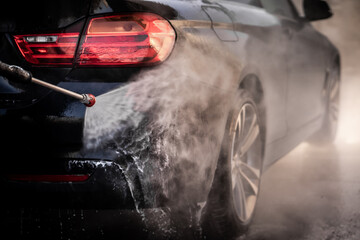Keeping a vehicle clean goes far beyond appearances. Car detailing is a thorough process designed to restore, protect, and maintain a car’s condition inside and out. Unlike a standard wash, which only tackles surface dirt, detailing focuses on every crevice and component, breathing new life into your car and extending its longevity. Whether you’re a car enthusiast or simply want to protect your investment, understanding the fundamentals of car detailing can help you appreciate why it’s worth the effort.

What Car Detailing Really Is
Car detailing is a comprehensive cleaning and reconditioning of a vehicle, from bumper to bumper. It typically involves deep-cleaning, restoration, and protection of both the exterior and interior surfaces. The goal is to rejuvenate the car’s appearance and preserve its value.
A detailed car not only looks stunning but also feels better to drive. Surfaces are cleaner, upholstery is fresh, and protective coatings guard against everyday wear and tear. Done correctly, detailing can even improve resale value by presenting the car in its best possible condition.
Exterior Detailing
The exterior of your car faces constant exposure to sunlight, dirt, pollution, and road debris. Over time, these elements can dull paintwork and corrode surfaces. Exterior detailing involves:
- Thorough washing: Using specialized techniques to remove dirt, grime, and tar without scratching paint.
- Decontamination: Removing embedded contaminants like tree sap or industrial fallout that regular washing can’t handle.
- Polishing: Eliminating minor scratches, swirl marks, and oxidation to restore gloss.
- Protection: Applying waxes or sealants to create a barrier against UV rays, water, and contaminants.
The result is a smooth, glossy finish that enhances your car’s appearance and helps protect the paint over time.
Interior Detailing
Interior detailing is just as important as the exterior. Dust, spills, and daily use can leave the inside of a car looking and smelling less than fresh. Interior detailing often includes:
- Vacuuming: Removing dirt and debris from carpets, seats, and crevices.
- Shampooing or steam cleaning: Deep-cleaning upholstery and floor mats to lift stains and odors.
- Leather treatment: Conditioning leather surfaces to keep them soft and crack-free.
- Dashboard and trim cleaning: Wiping down and protecting hard surfaces from fading or cracking.
A clean, well-maintained interior improves comfort, reduces allergens, and helps maintain your vehicle’s resale value.
Engine Bay Cleaning
Many people overlook the engine bay during regular cleaning, but a well-maintained engine compartment has practical benefits. Engine bay detailing involves gently cleaning and dressing components to remove built-up grease and grime. While this doesn’t make the car run better, it can help identify leaks, extend the life of parts, and impress potential buyers.
Benefits of Car Detailing
- Preserves value: Regular detailing helps maintain a car’s condition, making it more appealing to future buyers.
- Protects surfaces: Waxes, sealants, and interior protectants act as barriers against wear, UV damage, and spills.
- Improves safety: Clear, clean windows and headlights improve visibility, while a tidy cabin reduces distractions.
- Enhances driving experience: A fresh, clean car simply feels better to drive.
How Often to Detail a Car
The frequency of detailing depends on driving habits, climate, and storage conditions. Vehicles exposed to harsh weather or long commutes may need more frequent attention. A good general guideline is to detail your car every four to six months, but some owners choose to do it more often to keep their vehicles in top shape.
DIY Versus Professional Detailing
You can perform many detailing tasks yourself with the right products and patience. Washing, vacuuming, and basic waxing are straightforward. However, professional detailers offer expertise, specialized tools, and high-quality products that produce a deeper, longer-lasting result. They’re also skilled in correcting paint imperfections and tackling hard-to-reach areas safely.
If you decide to detail your car yourself, take the time to learn proper techniques. Using the wrong tools or methods can cause scratches, streaks, or damage to sensitive materials.
Tips for Effective Car Detailing
- Work in the shade to prevent cleaners or waxes from drying too quickly.
- Use microfiber towels to avoid scratching surfaces.
- Start from the top of the car and work downward to prevent redistributing dirt.
- Clean windows last for a streak-free finish.
- Be patient—detailing is about thoroughness, not speed.
These simple habits can dramatically improve your results and protect your vehicle’s appearance.
Protecting Your Car Between Detailing Sessions
Maintaining a car between full detailing sessions keeps it looking great longer. Quick weekly washes, wiping down interiors, and removing trash or spills promptly can prevent buildup. Investing in good floor mats and seat covers also makes cleaning easier and protects underlying materials.
Regular upkeep reduces the time and effort needed for the next full detail and helps preserve that freshly-cleaned look.
The Long-Term Impact of Car Detailing
Car detailing is more than a cosmetic indulgence—it’s preventive care. By addressing dirt, oxidation, and wear early, detailing prolongs the life of paint, upholstery, and trim. This not only enhances your daily driving experience but can also save you money on repairs and replacements over time.
In a way, detailing is like giving your car a health check. It keeps every part looking its best while helping you spot small issues before they become major problems.
A Fresh Start Every Time
Few things feel as satisfying as stepping into a freshly detailed car. The clean scent, spotless surfaces, and sparkling exterior create a sense of pride and enjoyment. Whether you do it yourself or hire a professional, car detailing is an investment in your vehicle’s appearance, comfort, and value.
With consistent care and attention, your car can look and feel like new for years to come—turning every drive into a more enjoyable experience.